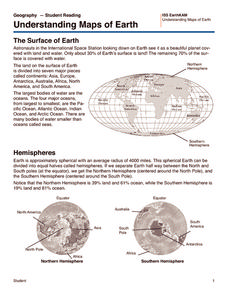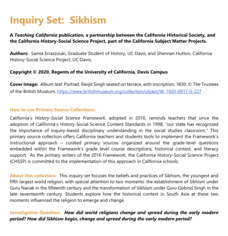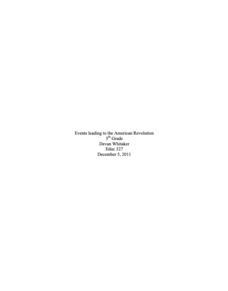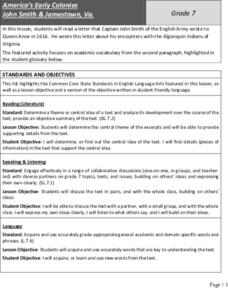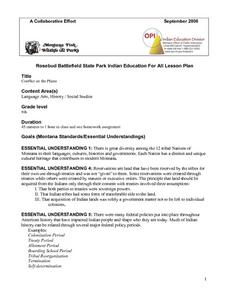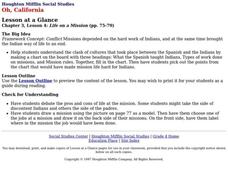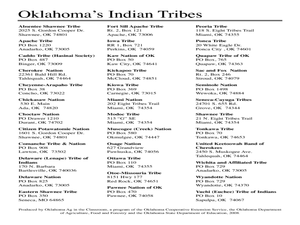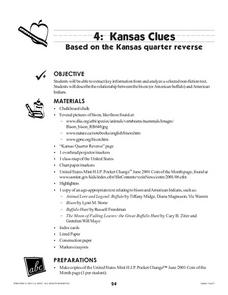Institute for Geophysics
Understanding Maps of Earth
Here is your go-to student resource on primary geography concepts, including facts about the surface of the earth and its hemispheres, latitude and longitude, globes, types of maps, and identifying continents and oceans.
University of Wisconsin
We're Off to India!
Pack your bags and set off to the wonderful country of India in a multi-day cultural unit. The lesson is a 17-day series focusing on literature, music, art, geography, and the culture of India. Scholars complete several activities,...
University of California
Influences from South to Southeast Asia
In ancient times, people along trade routes exchanged ideas in addition to goods. Scholars view eight primary sources, such as artwork, to understand how India influenced southern Asia. Academics participate in a short group discussion...
Race Briges Studio
I am Indopino: Or, How to Answer the Question, "Who Are You?"
In our increasingly multi-ethnic society, many students find it difficult to identify themselves as belonging to any one ethnicity. Gene Tagaban, a Tlingit, Cherokee, Filipino offers his personal experiences with these questions in his...
Smithsonian Institution
Native Resistance: Native Resistance Then and Now
Native Americans lost so much—and gained so little in return. Scholars explore Native Americans' resistance to the United States government. The lesson uses primary sources to explore the different forms of protest and gives a voice to...
NOAA
Into the Deep
Take young scientists into the depths of the world's ocean with the second lesson of this three-part earth science series. After first drawing pictures representing how they imagine the bottom of the ocean to appear, students...
University of California
Sikhism
How does a new religion start? The informative resource highlights the Sikhism religion. Academics learn how the religion was created and spread throughout the ancient world. Scholars view a series of primary sources and complete a...
Curated OER
The Seven Continents Scavenger Hunt
Who doesn't enjoy an engaging scavenger hunt? Here, scholars listen to, and discuss, the informative text, Where is my Continent? by Robin Nelson. They then explore the seven continents and four major oceans using...
Teaching History
Jamestown: The Starving Time
Students analyze a variety of primary and secondary sources to determine the cause of the Jamestown starving time during the winter of 1609–1610.
Manchester University
Events leading to the American Revolution
The Stamp Act, Paul Revere's ride, and the Boston Tea Party pushed American colonists to the tipping point that led to the American Revolution. Fifth graders research the key figures of the war, study the Declaration of Independence, and...
California State University
Life in the Missions of California
Academics explore the topic of life in California Missions for Native Americas. Class members complete a research activity, respond to writing prompts, and engage in hands-on-activities to learn who lived in the missions and what life...
National Endowment for the Humanities
Hopi Poetry
The Hopi refer to corn as their children, demonstrating its importance to the Native American group. Class members consider the role of literal and figurative language by examining poetry from this indigenous group. The resource includes...
National Endowment for the Humanities
Hopi Place Names
What's in a name? Historians consider the question as they examine places important to the Hopi people and the meanings of their place names. Included worksheets include maps and charts to help class members examine the geography of Hopi...
National Endowment for the Humanities
Hopi Traditional Dance and Song
Very few outsiders get to see the Hopi "Butterfly Dance." However, using approved footage from the tribe, class members consider the importance of symbols in Hopi culture by watching the dance and analyzing lyrics from its songs....
Center for History Education
Was the Stamp Act Fair?
Pledge your loyalty to the king and the Stamp Act or sign an oath against the tax. After simulating an in-class tax for school supplies, young historians consider the reasons for the Stamp Act and similar colonial policies. The...
Curated OER
America’s Early Colonies: John Smith and Jamestown, Va
John Smith's 1616 letter to Queen Anne of England offers ELLs an opportunity to learn about a bit of early American history. The four-page packet includes the full text of the letter. In addition, the packet includes a worksheet...
Curated OER
Conflict On The Plains
Eighth graders investigate the culture and lifestyles of the Lakota Sioux and the Northern Cheyenne tribes. They use a variety of resources for research. They create questions based on information to be used during classroom discussion...
Curated OER
CAPITALIZATION
Students write a class A,B,C book based on people and events important to the class. They use capital letters at the beginning of sentences and for proper names. They use periods at the end of sentences.
Curated OER
Oh, California
Students begin this instructional activity by charting information about the relationship between the Spanish missionaries and Native Americans at a California mission. Then, students identify the dynamics of those relationships that...
Curated OER
Plows on the Hunting Grounds
Students will examine and anaylze the assimilation of Native Americans in the US.
Curated OER
Kansas Clues
Young scholars examine the Kansas state quarter and the Buffalo nickel and look for clue to help them identify why the bison was so important to the Native American. They perform "freeze frames" depicting Native American use of the bison.
Curated OER
A Differentiated Way through Think Dots
Learners examine reasons that led people to explore, identify "West" as defined following Revolutionary War, explain importance of finding natural resources, develop time line of dates and events leading up to Lewis and Clark Expedition,...
Curated OER
Comparing Utah's Past and Present Government
Fourth graders research the past and present forms of government in Utah. In this government studies lesson students analyzes different forms of government and work with a group to gather information about how Utah was/is run and then...
Curated OER
Understanding Treaties: Students Explore the Lives of Yakama People Before and After Treaties
Students analyze treaties made between the US government and Native American tribes. In this government lesson plan, students evaluate bias emotionally connect with what was gained and lost during the late 1700's. This is a 3 part...
Other popular searches
- American Indians
- Sioux Indians
- Iroquois Indians
- Cherokee Indians
- Eastern Woodland Indians
- Wampanoag Indians
- Native American Indians
- Indians and Pilgrims
- Navajo Indians
- Lakota Sioux Indians
- Lakota Indians
- American Indians Lesson Plans
